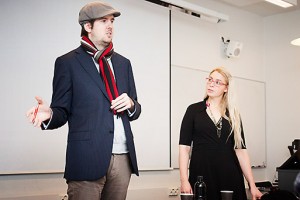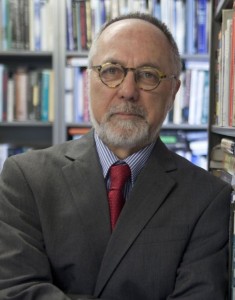Bridget Anderson, the Professor of migration and citizenship at Oxford University and the research director of COMPAS (Centre on Migration, Policy and Society), held a presentation at CEREN research seminar on 24th November. Her topic considered the rhetoric around the discussions on refugees and immigrants, as she introduced the perceptions of immigrants, on the other hand, as “hard workers”, and on the other hand, as “poor slaves”. Anderson reminds that human mobility is not a new phenomenon, and it has been regulated for centuries. However, migration as we understand it today appeared with the emergence of nation states and the idea of citizenship.
In the shadow of recent refugee developments in Europe, Anderson reflects how people use and understand the term ‘refugee’ nowadays. As ‘migrant’ tends to dehumanize people and relate them to negative contexts, the word ‘refugee’ refers in many conversations to the people in need of help and protection. Still, ‘refugee’ and ‘immigrant’ as terms are also legal terms, and therefore, they comprise different rights. According to Anderson, there is sometimes a contradiction between the rhetoric and the legal rights, which makes this subject a highly political matter. In addition, we should remember that we do not have refugees without economic migrants, and having asylum seekers requires the existence of deportations. In other words, inclusion creates exclusion and vice versa. The complexity arises from the question ‘under which rules do we include people?’
Like already mentioned the term ‘migrant’ is often used in a derogatory manner. Anderson exemplifies this by reminding how EU-migrants are in many settings called expats or mobile EU-citizens instead of migrants. Thus, it is possible to claim that in today’s world ‘migrants’ represent the global poor. As the place of birth tends to define the levels of wealth, the human mobility from the Global South to the developed countries is conceived often as a threat to our Western lifestyles. Migrants appear also as a risk to the welfare state as its capacity is not enough to take care of all the impoverished in the world. This reveals a motive for exclusion. Moreover, images of nation relate still rigidly to images of ancestry and race.
Anderson introduces the two diverse discourses on economic immigrants: the first one perceiving migrants as “poor slaves” suffering from constant exploitation, and the second one presenting these non-citizens as hardworking economic contributors. The metaphors from the historical cross-Atlantic slave trade highlight the dimension how immigrants, especially the ones crossing the Mediterranean Sea, have been taken advantage of. Despite the similar risks of the dangerous sea travels in overcrowded boats in common to “new and old slavery”, Anderson underlines that these two are very different phenomena. Whereas today’s smuggled migrants pay voluntarily to get illegally into Europe, the slaves of the cross-Atlantic slave trade were kidnapped against their will. In addition, the slave traders until the 19th century were practicing a legal profession.
The other common rhetoric on immigrants conceives them as “good workers” having an extremely good work ethics, and therefore, being more desirable employees. It is acknowledged that immigrants accept low-paid and seasonal jobs and work with anti-social hours, which do not attract the native populations. However, like Anderson notes, this is partly due to the fact that immigrant regimes build systems, in which immigrants depend on their employers. For instance, the links between work and residency force immigrants to certain flexibility. Furthermore, as the immigrant rules make immigrants to leave their families behind, they can accept seasonal contracts and large amounts of night shifts, which is often impossible for natives with families. This shows how “good work ethics” does not explain everything. Anderson highlights how we need to recognize both the differences and the connections of immigrants and citizens. According to her, “poor slave”, same as “good worker” presents a special case, and thus may hinder us seeing these crucial linkages. Immigration control has impacts on citizens as well as immigrants: the rights of natives and immigrants are extremely interlinked.
Written by Ulla-Kaisa Pihlaja
 Martinovic started her presentation by talking about the theory of social representation and in specific research establishing the importance of social representation of history for current intergroup relations. Her own research focus is on historical claims of territorial ownership. Intergroup relations often revolve around the question of “who owns the country”. The question of ownership and entitlements is relevant also in more peaceful immigrant receiving societies. Martinovic pointed out that even if there is no legal ownership to be claimed, there may be a strong idea of collective psychological ownership. Historical narratives can be used to claim ownership and affect present day intergroup relations. Autochthony meaning entitlement for firstcomers, is a concept that Martinovic has adopted in her research. She has been working with case studies in Australia, USA, Transsylvania and the Chilean and Bolivian border area where she has researched different types of historical ownership claims. One conclusion she has made is that the way we interpret intergroup history guides our attitudes towards out-groups in the present.
Martinovic started her presentation by talking about the theory of social representation and in specific research establishing the importance of social representation of history for current intergroup relations. Her own research focus is on historical claims of territorial ownership. Intergroup relations often revolve around the question of “who owns the country”. The question of ownership and entitlements is relevant also in more peaceful immigrant receiving societies. Martinovic pointed out that even if there is no legal ownership to be claimed, there may be a strong idea of collective psychological ownership. Historical narratives can be used to claim ownership and affect present day intergroup relations. Autochthony meaning entitlement for firstcomers, is a concept that Martinovic has adopted in her research. She has been working with case studies in Australia, USA, Transsylvania and the Chilean and Bolivian border area where she has researched different types of historical ownership claims. One conclusion she has made is that the way we interpret intergroup history guides our attitudes towards out-groups in the present. 



